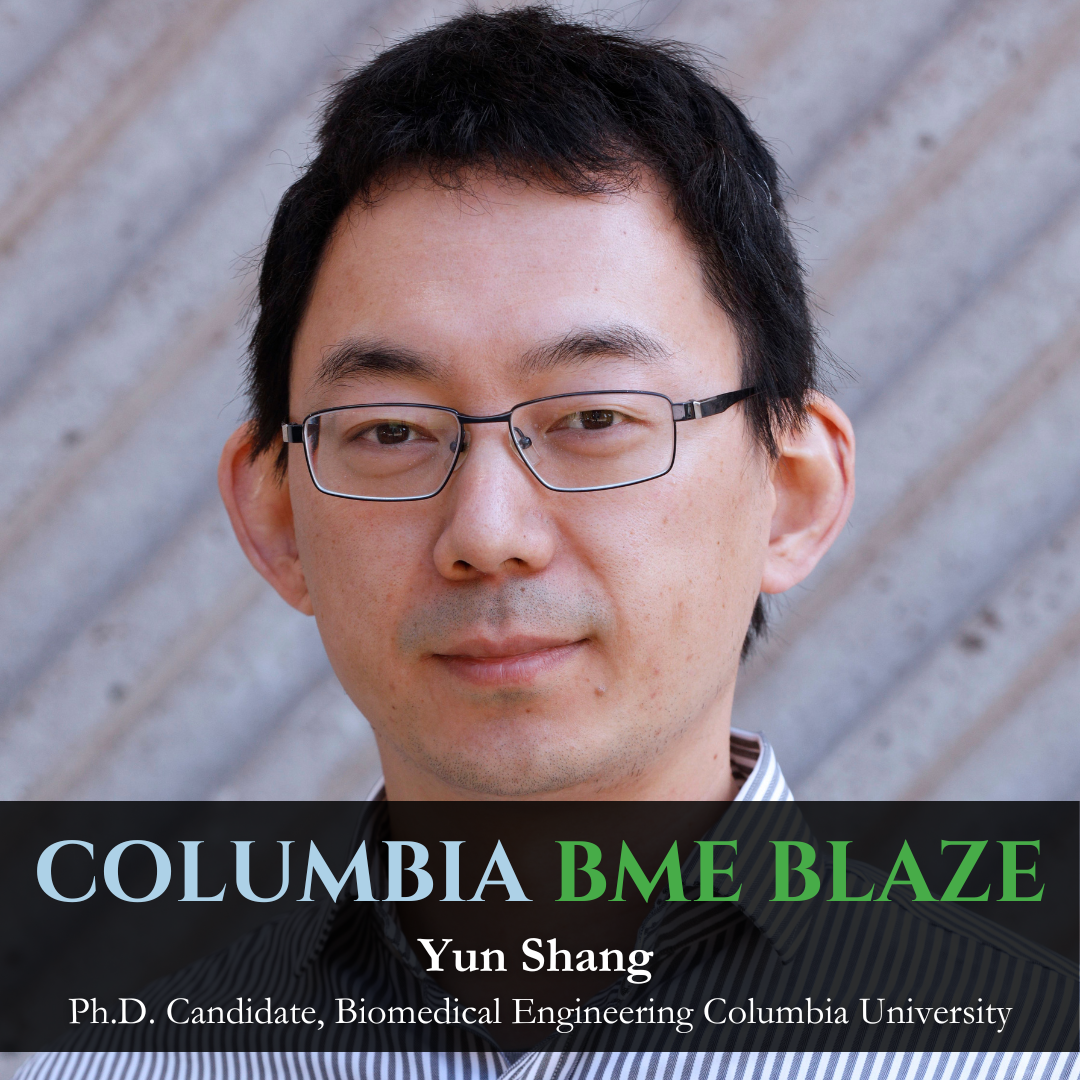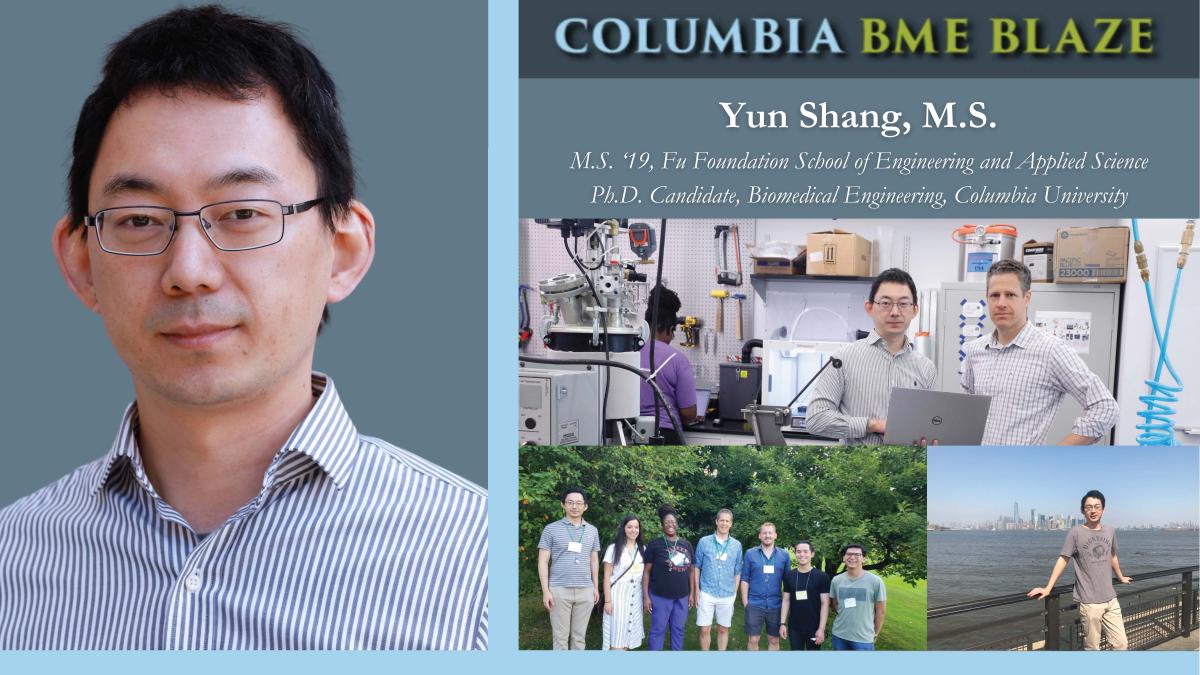October 2023 - BME Blaze: Yun Shang
In this monthly spotlight, get to know the alumni and students of Columbia's Department of Biomedical Engineering. Read what our BME folks are up to, from our labs' latest research, to our students' plans for the future, to our teams' innovations, start-ups, and other career successes. We enjoyed catching up with Columbia BME PhD student,Yun Shang as he discussed her experience at Columbia BME. Read below to get to know Yun!

Education
- Master of Science, Biomedical Engineering, 2019, Fu Foundation School of Engineering and Applied Science
Where are you from?
I’m from Shanghai, China
What drew you to the field of Biomedical Engineering?
My first inspiration came from my major during my undergraduate study, Medical Imaging Engineering. Even though this is a branch in the field of Biomedical Engineering (BME), but it actually enables me to enter this field. I learned about imaging techniques like X-rays, computed tomography (CT), ultrasound, magnetic resonance imaging (MRI), and nuclear imaging as well as human anatomies. I was attracted to the combination of engineering and medical applications of these techniques in disease diagnostics. During that time, I had already decided to pursue a career in MRI due to its wide variety of imaging contrasts and use cases. This is also the reason I finished my Master's degree in the same field and worked in the MRI industry afterward. Based on my background in physics and MR system engineering, my long-term goal is to develop the most accurate MR scanner, facilitating the clinicians for better image quality and more accurate disease diagnostics. As a result, I applied for a Ph.D. program at BME.
What is your current role?
I’m currently a Ph.D. candidate in the MR SCIENCE Laboratory at BME department. My current research involves developing technology for controlling the magnetic field inside MR scanners, ensuring a more homogeneous field within human body, known as B0 shimming technique. The project of mine involves collaborations with prestigious colleges and institutes around the world in the development of an accessible superconductive head-only MR scanner that breaks the barrier for subjects not being accessible to the natural environment as well as provides a platform for developing advanced imaging methodology. My laboratory designed and manufactured a multi-coil array at an industrial level for simultaneous B0 shimming and arbitrary linear and nonlinear image encoding. Additionally, I was focusing on the research regarding the B0 magnetic field simulation within human bodies. For the first time, our study shows highly detailed B0 conditions within human heart across cardiac cycle consistent with B0 distributions computed based on subjects’ anatomy from first principles of physics considering motion-induced geometry changes. It will help researchers and clinicians to optimize cardiovascular MRI for improving image quality and diagnostic accuracy.
Why did you choose Columbia BME?
My main reason for choosing Columbia BME is because of my P.I., Prof. Christoph Juchem, whom I am working with. When I searched for a Ph.D. program in 2016, Prof. Juchem joined the BME at that time. By reading his papers, I was able to gain a better understanding of his background and work. I was attracted to his research focus because I had the same interests as he did, and I admired his precise style and rigid ideas that were associated with his research. Also, I appreciate Prof. Laine's recommendation after I had an interview with him. I feel lucky that my P.I. selected me providing me the opportunity to become a research scientist.
What were some of your favorite projects/memories from the program?
I remember a few times when I felt frustrated during my project, these were the moments that helped me grow the most. One of the memorable experiences was the first patient scan with the MR scanner. It took us years on developing the techniques and testing on volunteers as well as efforts on getting the patient to realize the first scan. This scan required the subject to hold breath for a short time, however, this patient was not able to do it even though we got the confirmation during screening. The major reasons come from the patient’s clinical conditions in the heart. The scan was stopped without obtaining meaningful data, which makes me feel frustrated. However, it turned out that the first scan provided us an important lesson about the clinical applicability of our technique and selection of patient population. Based on that experience, we tuned our scan strategy and changed our patient population and successfully acquired the first patient data afterward.
What was your proudest moment at Columbia?
The proudest moment at Columbia was the successful completion of my first independent patient MR scan. After years of research, we have developed a method for simulating magnetic fields in the human heart, assuming that the subject is inside the magnet of an MR scanner, by using structural images from other modalities, like CT images. We aimed to validate our simulation method by recruiting the patient who was prescribed to undergo CT scanning and comparing the simulation results with those acquired in vivo from the same patient. It takes years of effort to complete the first patient scan: development of the simulation method, in vivo cardiac mapping on the scanners, healthy volunteer tests, IRB approval, and the recruitments. We would not be able to do this without the support of our research collaborators at Columbia Medical Center and GE Healthcare. This is a milestone not only for proving our method is accurate, but also for allowing for more advanced technology development and grant applications in the future.
How has your experience with Columbia BME contributed towards your goals?
Prior to coming to Columbia BME, my background was primarily in engineering. The courses offered at BME, such as quantitative physiological modeling and biomechanics, enable me to bridge the knowledge gap between engineering and medical usage. My research involves cardiovascular MRI, so those courses help me to better understand the clinical impact of myocardial strain imaging and diffusion tensor imaging. The BME undergraduate laboratory and the machine shop are also critical resources for my research, especially in the beginning when our laboratory has not yet been fully set up. Additionally, our department and the university as a whole are very humanistic and BME has a diverse and culturally inclusive population, which ensures a very tolerant and harmonious cultural environment for students, particularly for an international student like myself, that I feel very comfortable in.
What are your thoughts on the strength of Columbia BME's alumni network and how has that influenced your career path?
BME is very much cross-disciplinary, the resources in BME’s alumni network are broad and powerful. Many of our alumni are easy to communicate, and they work in various research areas across the country and even worldwide, we can always reach out to them for career advice.
Any words of wisdom or tips for prospective BME students?
As a researcher and engineer in MRI, one of the most important things is to identify the killer application of our technique in clinical usage. It cannot be achieved without the collaboration of doctors, radiologists, and clinicians in the research process. In my opinion, it is very important to bridge the gap between engineering and medical use cases, such as disease diagnosis and therapy. There are many aspects to the human body, and we are all different. Our MRI scan protocols have been tested on multiple healthy volunteers and I have also gone through all the steps for the in vivo scan, but every patient has new problems and challenges. However, those experiences have helped me to better understand clinical conditions, and to refine our protocols and procedures to fit a greater number of patients. Finally, I think it is very important to build confidence for any challenges you will face particularly for a new student who lacks research experience. Be well-prepared for any problems you are focusing on and work on them until you succeed.
What are you excited about?
I’m excited about my years of studying at BME will allow me to grow and become a research scientist in the future.

Images (clockwise from top):
- Project discussion with my P.I. Prof. Christoph Juchem in the lab.
- Visit the Statue of Liberty, 2018.
- Family picnic in Van Saun County Park, Paramus, NJ, 2021.
COLUMBIA BME ACADEMICS
Our department and the university as a whole are very humanistic and BME has a diverse and culturally inclusive population, which ensures a very tolerant and harmonious cultural environment for students, particularly for an international student like myself, that I feel very comfortable in.
